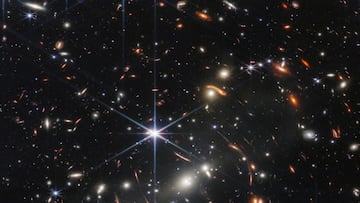Where can I see NASA’s James Webb Space Telescope images?
The most powerful telescope we have is looking back more than millions and billions of years deep into the beginning of our universe.

The deepest and sharpest image of the Universe captured by the James Webb telescope, was presented at an event at the White House in which the president of the United States, Joe Biden, spoke.
“These images are going to remind the world that America can do big things, and remind the American people – especially our children – that there’s nothing beyond our capacity,” he said during the event. “We can see possibilities no one has ever seen before. We can go places no one has ever gone before.”
Newest pictures from James Webb telescope
The finding has allowed the instrument launched into space on December 25 to obtain an infrared image and fulfill the main purpose of its launch, which is none other than to capture the light of the first stars that emerged after the Big Bang, where the universe began. Known as Webb’s First Deep Field, this first image reveals the galaxy cluster SMACS 0723, a region of the sky visible from the southern hemisphere, as it was 4.6 billion years ago.
However, at NASA they go further and emphasize that this first image is only a preview of what is to come.
“Webb’s First Deep Field is not only the first full-color image from the James Webb Space Telescope, it’s the deepest and sharpest infrared image of the distant universe, so far. This image covers a patch of sky approximately the size of a grain of sand held at arm’s length. It’s just a tiny sliver of the vast universe,” said Bill Nelson, a NASA Administrator.
“This mission was made possible by human ingenuity – the incredible NASA Webb team and our international partners at the European Space Agency and the Canadian Space Agency. Webb is just the start of what we can accomplish in the future when we work together for the benefit of humanity.”
This is an image that has been captured by the NIRCam instrument, the only one of the four that the telescope has that has been developed by American institutions. On the other hand, the telescope, during the next 20 years, will observe some of the first galaxies created in the universe to understand their evolution over millions of years in the Milky Way, and will carry out a verification of the possible existence of habitable planets.
This image is among the telescope’s first-full color images. The full suite will be released Tuesday, July 12, beginning at 10:30 a.m. EDT, during a live NASA TV broadcast.
James Webb provides “a new vision of the world”
The head of NASA's scientific mission, Thomas Zurbuchen, explained that this finding revealed by the James Webb telescope represents "a new vision of the world". A mission in which they operate together with NASA, the Canadian and European space agencies.
Further excited comments and questions came from John Mather, Webb senior project scientist at NASA’s Goddard Space Flight Center in Greenbelt, Maryland..
“Scientists are thrilled that Webb is alive and as powerful as we hoped, far beyond Hubble, and that it survived all hazards to be our golden eye in the sky.
“What happened after the big bang? How did the expanding universe cool down and make black holes and galaxies and stars and planets and people? Astronomers see everything twice: first with pictures, and then with imagination and calculation. But there’s something out there that we’ve never imagined, and I will be as amazed as you are when we find it.”
Since its launch into space, the James Webb has recorded its first flash of light. A fact that has allowed him to collect information to align the 18 mirrors it has, and allowed it to capture images that are initially out of focus and use them to slowly adjust the telescope, which reached its destination (Langrange 2) a month after its release.





